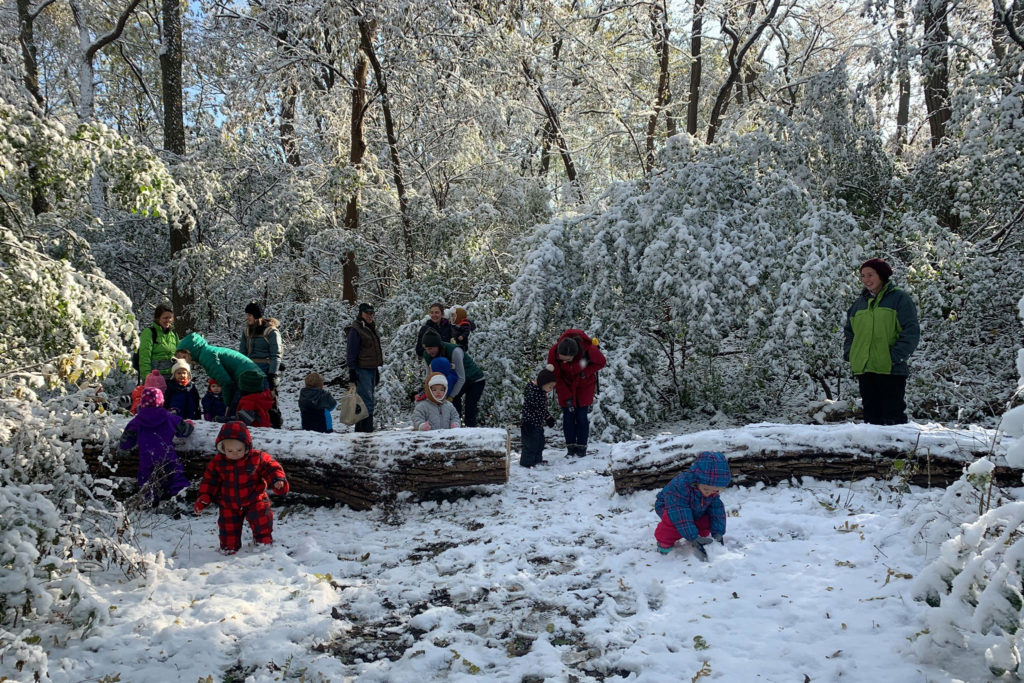
With technology and screens at the forefront of modern parenting, many moms and dads are seeking ways to get their kids back to the basics of their own childhoods.
Cue a little adventure in the great outdoors! The more research shows that kids need to get back outside, the more parents are looking for ways they can prioritize it.
Free Forest School is a nonprofit organization encouraging parents to do just that.
“Free Forest School ignites children’s innate capacity to learn through unstructured play in nature, fostering healthy development and nurturing the next generation of creative thinkers, collaborative leaders and environmental stewards,” the organization states on its website.
The organization was first founded in New York and now has nearly two hundred chapters all over the globe. Wisconsin is home to two — Free Forest School of Dane County and a chapter that just started in Milwaukee.
Free Forest School Dane County facilitators Codie Heidemann and Amy Schmudlach give more insight into this approach to an adventurous education.
How does nature-based learning play impact a child’s development?
Amy: It is difficult to find an area of child development that is NOT impacted by nature-based learning. It helps with physical development. Kids challenge their bodies by climbing, running and jumping, which is building gross motor skills as well as confidence. They are exposed to a variety of senses outdoors that they are missing if they just play inside. They experience the feel of grass on their toes, listen to birds chirping and also feel the wind on their cheeks, so their bodies learn to process these senses. They build creativity by making swords out of sticks and forts in the trees and encounter opportunities for decision making and problem-solving that they aren’t exposed to in an indoor environment.
What does unstructured, risky play look like?
Amy: It looks like kids testing the limits of their comfort zones while they play, without being given a specific goal of something to accomplish or learn. They might engage in risky play by climbing, running, jumping, throwing. Or they might test their boundaries by exploring an area further away from adults, walking on frozen ice or swinging a stick around. It is the kind of play that happens naturally when we let kids be kids!
How can the parents benefit from Free Forest School?
Amy: Adults benefit from FFS in many of the same ways that kids do. Many people who spend time outdoors find that it helps them feel more relaxed and less stressed. Committing to attend FFS is a great way to fit time outdoors into a busy schedule, and it is a great place to make friends and build community!
What age group is Free Forest School for?
Codie: Free Forest School is geared toward children ages up to six years old. However, it is not uncommon to find meetups for school-aged children as well. Right now, we have one group that meets in the afternoon after school lets out for the day. The parents and caregivers felt it was important to provide an opportunity for those kids to have unstructured time to play in nature with their peers. That specific group has older kids that attend, but it is open to all ages. I enjoy bringing my younger kids to that group because they get the chance to learn new things by observing how older children play in and interact with the outdoors. The older kids are excellent peer models!
The same can be said for our meet-ups that have younger participants too. It is so fascinating to watch the interactions between young children, as well as the different ways they choose to engage in nature play.
What does a meet-up look like?
Codie: A typical meet-up includes a welcome time where we participate in a shared (nut-free) snack at the start. The shared snack builds community and provides the chance to fill up hungry bellies, allowing for more focused time in unstructured play. From there we have at least sixty minutes of play with parents using the “lightest touch” approach. Meaning, parents step back and only intervene if or when necessary to allow kids to use their imagination, explore, assess risk, interact with peers, etc. After our playtime, we gather again for circle time. During this time we snack (bellies are hungry again!), read stories, sing songs do an activity together. Once circle time is done, families are encouraged to continue their play. The colder months, especially in Wisconsin, can be challenging for extended play but as the days get warmer it will be much easier!
We currently have four different meet-ups in Dane County. We are always looking for more volunteers to host a group. The more groups we have the more accessible Free Forest School is to our community.
Any tips for families to make getting outside together a priority?
Codie: Start small. If getting outside with your family is challenging, or you’re having trouble making it a priority, set small goals throughout the week to spend more time outside. It doesn’t have to be a grand adventure each time. Something as simple as taking a short walk around the neighborhood, squishing your toes in the grass in your yard or going to a local park are all great ways to spend time outside! The more you practice making outside time a priority, the more it will be a natural part of your family routine. Amy: Try to find other families who also want to get outside. I’ve always found it is easier (and more fun!) to do it with other people.
Megan Kulick is a journalism graduate of the University of Wisconsin-Platteville. She worked in the nonprofit field for seven years before becoming a stay-at-home mom. She and her husband, alongside their daughter and labradoodle, live in Mount Horeb. She is always in pursuit of a great trail to run, a good book to read and the best place to find a good iced coffee.